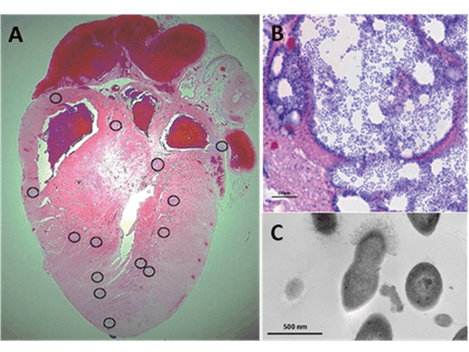Can one catch a heart disease? As strange as it may sound, recent studies reveal that bacterial infections may directly damage the heart.
As early as 1999, the infection of a common bacterium Chlamydia was demonstrated to induce heart damage via an antigenic mimicry-based, auto-immune disorder in which immune cells mistarget the heart cells in the process of killing the bacterium (Bachmaier et al. 1999). More recently, Brown et al. have presented striking evidence showing that Streptococcus pneumoniae (S. pneumoniae), a common Gram-positive pathogenic bacterium, translocates into the heart muscle and induce microlesions that disrupt heart function (Brown et al. 2014).
S. pneumoniae infection induces myocardial tissue injury
S. pneumoniae, also known as the pneumococcus, is the most common cause of sepsis and community-acquired pneumonia (CAP). Severe CAP carries an extensively documented risk for adverse cardiac events, including congestive heart failure, arrhythmias, and myocardial infarction. Infection of S. pneumoniae in mice leads to invasive pneumococcal disease (IPD), the severity of which correlates with levels of serum troponin I (Tn-I), a biomarker for myocardial tissue injury. Indeed, when Brown et al. injected BALB/c mice with S. pneumoniae strain TIGR4 intraperitoneally, they found that bacterial titers from the mice correlated significantly with the animals’ Tn-I levels. Abnormal electrocardiogram (ECG) profiles recorded from the infected mice also suggest that the animals’ conductive systems were damaged.
Pathological studies of the hearts from S. pneumonia-infected mice revealed microscopic lesions randomly distributed throughout the ventricular myocardium (Fig. 1A) that were distinct from lesions associated with inflammatory heart conditions, such as myocarditis or pericarditis. The S. pneumonia-induced microlesions are characterized by the expansion of the interstitium between cardiomyocytes (heart muscle cells), extracellular vacuolation, the apparent loss of cardiomyocytes, and the stark absence of infiltrating immune cells within the lesion and the surrounding tissue. Importantly, high-power light microscopy (Fig. 1B) and transmission electron microscopy (Fig. 1C) revealed bacteria with diplococcal morphology within the microlesions. Similar lesions were observed in TIGR4-infected C57BL/6 mice and in BALB/c mice infected with a different S. pneumoniae serotype (serotype 2, strain D39).

Exposure to pneumolysin induces cardiomyocytes death
Because pneumolysin, a pore-forming toxin produced by S. pneumonia, could be detected by immunohistochemistry among the dead and dying cardiomyocytes in the cardiac microlesions from the bacteria-infected mice, Brown et al. sought to determine whether pneumolysin, alone, could induce cardiomyocyte death. They found that recombinant pneumolysin, but not the purified pneumococcal cell wall, induces cell death in cultured rat HL-1 atrial myocytes, indicating that pneumolysin can kill heart muscle cells directly. In addition, mice infected with a pneumolysin-deficient S. pneumoniae mutant develop significantly fewer and much smaller lesions than mice infected with pneumolysin-sufficient bacteria.
Previous studies demonstrated that pneumolysin triggers NLRP-3 inflammasome activation (de Bakker et al. 1988), resulting in caspase 1 activation and interleukin 1β(IL-1β) secretion and, in some instances, cell death by pyroptosis (Fang et al. 2011). Brown et al., however, failed to detect IL-1β at either microlesion sites or in the supernatants from pneumolysin-treated HL-1 myocytes. Further, microlesions morphologically similar to those found in S. pneumonia-infected wild-type mice were observed in S. pneumonia-infected caspase-1 knockout mice (B6N.129S2-Casp1tm1Flv/J (016621)), suggesting that microlesion formation is not dependent on inflammasome activation
Antibodies against pneumolysin and the bacterial adhesin CbpA reduce lesion formation
The authors then investigated whether antibodies against pneumolysin or choline binding protein A (CbpA), an adhesin required for S. pneumonia translocation across the vascular endothelium, can reduce microlesion formation. Mice were immunized with various pneumolysin or CbpA fusion protein constructs including: 1.) recombinant R1 domain of CbpA that contains the Laminin receptor (LR) and polymeric immunoglobulin receptor binding domains (YPT) of CbpA (CbpA-R12), 2.) pneumolysin toxoid, L460D, 3.) L460D fused with the LR domain of CbpA (L460D-NEEK), 4.) L460D fused with the the CbpA YPT domain (YPT-L460D) and 5.) L460D fused to both the CbpA LR and YPT domains (YLN). All immunized mice developed high antibody titers to the appropriate pneumolysin and (or) CbpA antigens used in the immunogens. When the immunized mice were subsequently exposed to a high bacterial challenge (105CFU) to avoid early clearance due to pre-existing antibody, cardiac microlesion formation was significantly reduced in mice immunized with L460D-LR fusion protein antigens L460D-NEEK and YLN, but not in those immunized with just CbpA-R12 or L460D or YPT-L460D fusion protein. These data suggest that microlesion formation might be preventable using antigen-based therapies, but that targeting domains in both CbpA and pneumolysin may be required.
Most of us are familiar with the risk factors for heart diseases, which include family history, poor diet, lack of exercise, hypertension, diabetes, excessive drinking, and smoking. Although patients with pneumococcal infections are at a higher risk for cardiac events than non-CAP patients, it has not been clear how these infections translated into increased mortality risk, even long after the infections had resolved. The work of Brown et al. demonstrates that bacteria can infect the myocardium directly where they trigger irreversible heart damage that may contribute to subsequent heart disease. It seems likely that we will have to add infection on the list of heart disease risk factors, and it is possible that anti-bacterial, vaccine-based therapies may prove efficacious someday in preventing heart disease.
Several BALB/c and C57BL/6 strains are available from the Jackson laboratory (see below) that can be used for infectious and other disease research.
| BALB/c Substrains | C57BL/6 Substrains |
| BALB/cBy (000650) | C57BL/6J (000664) |
| BALB/cByJ (001026) | C57BL/6NJ (005304) |
| C57BL/6ByJ (001139) | |
| C57BL/6JEiJ (000924) |